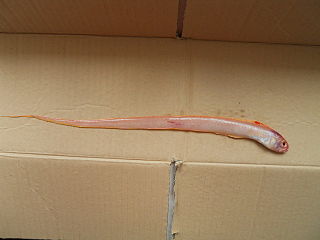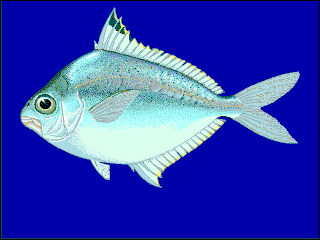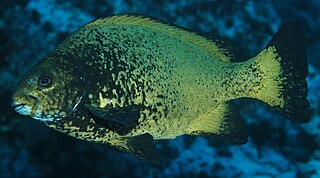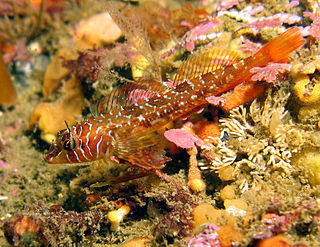
Gasterosteoidei is a suborder of ray-finned fishes that includes the sticklebacks and relatives, the 5th edition of Fishes of the World classifies this suborder within the order Scorpaeniformes.

Scorpaenoidei is a suborder of ray-finned fishes, part of the order Scorpaeniformes, that includes the scorpionfishes, lionfishes and velvetfishes. This suborder is at its most diverse in the Pacific and Indian Oceans but is also found in the Atlantic Ocean.

The bandfishes, family Cepolidae, are 23 species of marine ray-finned fishes, They are native to the East Atlantic and Indo-Pacific wherethey dig burrows in sandy or muddy seabeds and eat zooplankton.

Leiognathidae, the ponyfishes, slipmouths or slimys / slimies, are a small family of fishes in the order Perciformes. They inhabit marine and brackish waters in the Indian and West Pacific Oceans. They can be used in the preparation of bagoong.
Pteroini is a tribe of marine ray-finned fishes, one of two tribes in the subfamily Scorpaeninae. This tribe includes the lionfishes, sawcheek scorpionfishes and turkeyfishes. The taxonomy of the scorpionfishes is in some flux; the 5th Edition of Fishes of the World treats this taxa as a tribe within the subfamily Scorpaeninae of the family Scorpaenidae within the order Scorpaeniformes, while other authorities treat it as a subfamily within a reduced family Scorpaenidae within the suborder Scorpaenoidei, or the superfamily Scorpaenoidea within the order Perciformes.

Percoidei is one of 3 suborders of bony fishes in the order Perciformes. Many commercially harvested fish species are considered to be contained in this suborder, including the snappers, groupers, basses, goatfishes and perches.

Cepola is a genus of marine ray-finned fishes belonging to the bandfish family, Cepolidae. The name red bandfish is applied to all members of this genus, but particularly C. macrophthalma, and generally not C. australis, which is also known as the Australian bandfish.

Platycephaloidei is a suborder of ray-finned fishes, part of the order Scorpaeniformes, and includes the flatheads, ghost flatheads and sea robins.

Acanthocepola is a genus of marine ray-finned fishes belonging to the family Cepolidae, the bandfishes. They are native to the Indian Ocean and the western Pacific Ocean.
Owstonia is a genus of marine ray-finned fish belonging to the family Cepolidae, the bandfishes. It is the only genus in the monotypic subfamily Owstoninae. They are found in deep waters of the Indian and Pacific Ocean.
Owstonia taeniosoma is a species of marine ray-finned fish belonging to the family Cepolidae, the bandfishes. It is known from the Indo-West Pacific region.

Cottoidei is a suborder of ray-finned fishes which, according to the 5th edition of Fishes of the World, is placed within the order Scorpaeniformes, alongside the scorpionfishes, flatheads, eelpouts, sticklebacks and related fishes.

The Australian bandfish is a species of bandfish in the family Cepolidae. It has been reported from the Indo-Pacific coastal regions of Australia, New Zealand, and New Caledonia, although some of these records may represent confusion with other species.
Cepola schlegelii i is a species of marine ray-finned fish belonging to the family Cepolidae, the bandfishes. It is found in the Indo-West Pacific region.

Callionymiformes is an order of bony fish containing two families, the dragonets Callionymidae and the Draconettidae. In some taxonomies these families make up the suborder Callionymoidei of the wider grouping known as Perciformes, Nelson (2016) recognised the order but subsequent workers have suggested that if Callionymiformes is recognised as an order then the order Syngnathiformes is rendered paraphyletic and include Callionmyoidei within that taxon.

Acanthuriformes is an order of ray-finned fishes, part of the Percomorpha clade. Some authorities place the fishes in the order within the Acanthuriformes in the suborders Acanthuroidea and Percoidea of the order Perciformes.

Cepolinae is one of two subfamilies of marine ray-finned fish belonging to family Cepolidae, the bandfishes.

Siganoidea is a superfamily belonging to the suborder Percoidei which in turn is the largest suborder of the order Perciformes. It contains two families of largely Indo-Pacific distribution.

Scorpaenini is a tribe of marine ray-finned fishes, one of two tribes in the subfamily Scorpaeninae. This tribe contains the "typical" or "true" scorpionfishes. The taxonomy of the scorpionfishes is in some flux, the 5th Edition of Fishes of the World treats this taxa as a tribe within the subfamily Scorpaeninae of the family Scorpaenidae within the order Scorpaeniformes, while other authorities treat it as a subfamily within a reduced family Scorpaenidae within the suborder Scorpaenoidei, or the superfamily Scorpaenoidea within the order Perciformes.

Jordaniidae is a small family of marine ray-finned fishes belonging to the order Scorpaeniformes. These fishes are found in the eastern North Pacific Ocean.















